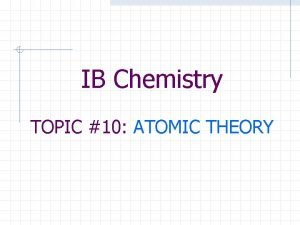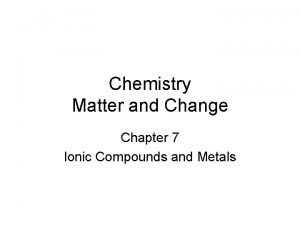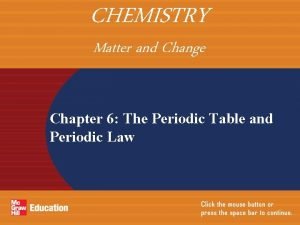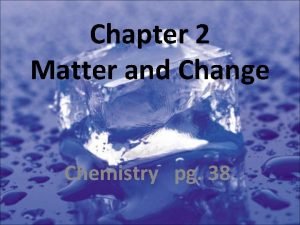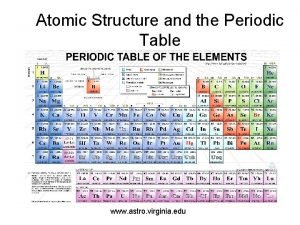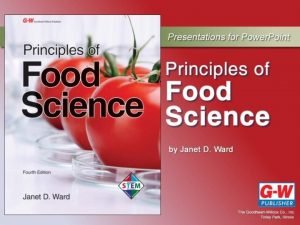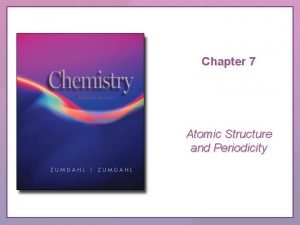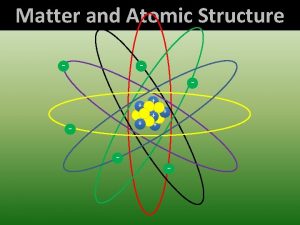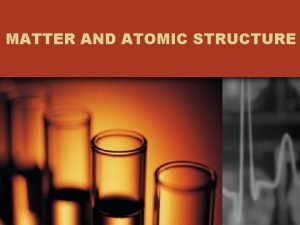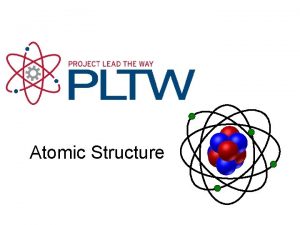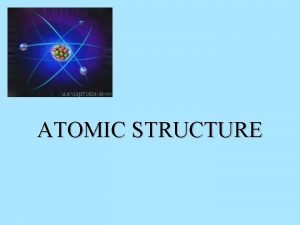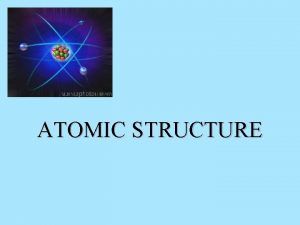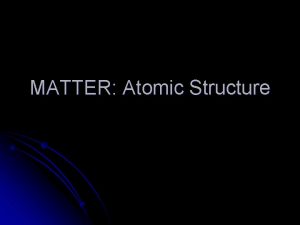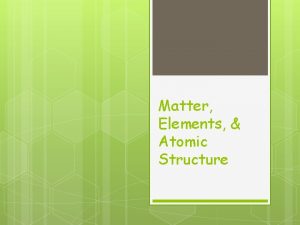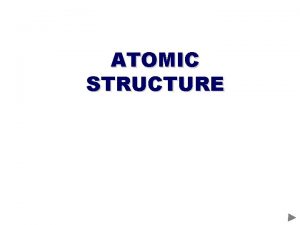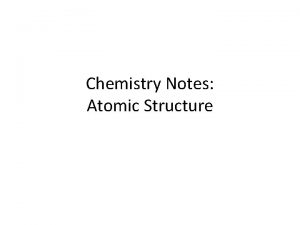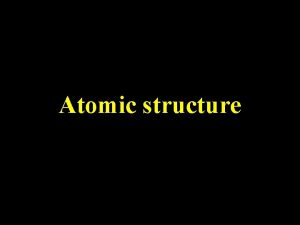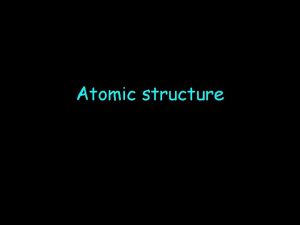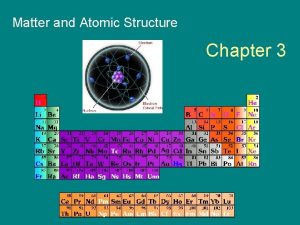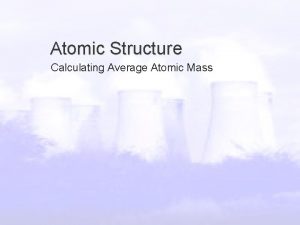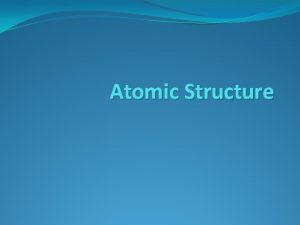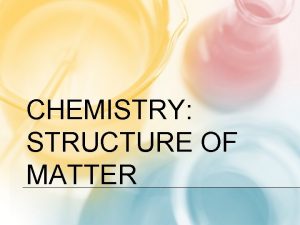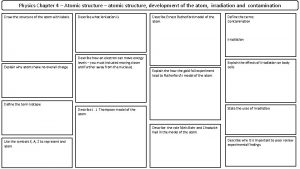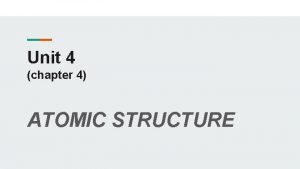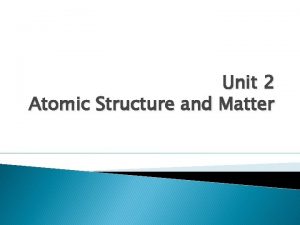Chemistry Chapter 2 Matter Elements and Atomic Structure


























- Slides: 26

Chemistry – Chapter 2 Matter, Elements, and Atomic Structure Chemical Bonding Properties of Water

Matter: Elements and Compounds Matter is anything that occupies space and has mass. Matter is found on Earth in three physical states: solid, liquid gas © 2013 Pearson Education, Inc.

Matter: Elements and Compounds Matter is composed of chemical elements. a substance that cannot be broken down into other substances by chemical reactions There are 92 naturally occurring elements on Earth. All of the elements are listed in the periodic table. © 2013 Pearson Education, Inc.

Figure 2. 3

Carbon (C): 18. 5% Oxygen (O): 65. 0% Calcium (Ca): 1. 5% Phosphorus (P): 1. 0% Potassium (K): 0. 4% Sulfur (S): 0. 3% Sodium (Na): 0. 2% Chlorine (Cl): 0. 2% Hydrogen (H): 9. 5% Nitrogen (N): 3. 3% Magnesium (Mg): 0. 1% Trace elements: less than 0. 01% Boron (B) Chromium (Cr) Cobalt (Co) Copper (Cu) Fluorine (F) Iodine (I) Iron (Fe) Manganese (Mn) Molybdenum (Mo) Selenium (Se) Silicon (Si) Tin (Sn) Vanadium (V) Zinc (Zn)


Matter: Elements and Compounds Elements can combine to form compounds. Compounds are substances that contain two or more elements in a fixed ratio. Common compounds include Na. Cl H 2 O © 2013 Pearson Education, Inc.

The Structure of Atoms Each element consists of one kind of atom. An atom is the smallest unit of matter that still retains the properties of an element. Atoms are composed of subatomic particles. A proton An electron A neutron © 2013 Pearson Education, Inc.

Figure 2. 2 Atoms are made up of protons and neutrons located within the nucleus, and electrons surrounding the nucleus.

Electron First electron shell (can hold 2 electrons) Hydrogen (H) Atomic number 1 Outer electron shell (can hold 8 electrons) Carbon (C) Atomic number 6 Nitrogen (N) Atomic number 7 Oxygen (O) Atomic number 8

Chemical Bonding and Molecules Chemical reactions enable atoms to give up or acquire electrons, completing their outer shells. Chemical reactions usually result in atoms staying close together and being held together by attractions called chemical bonds. © 2013 Pearson Education, Inc.

Ionic Bonds When an atom loses or gains electrons, it becomes electrically charged. Charged atoms are called ions. Cation (+) Anions (-) Ionic bonds are formed between oppositely charged ions. © 2013 Pearson Education, Inc.

Fig 2. 07

Covalent Bonds A covalent bond two atoms share one or more pairs of outer-shell electrons. Covalent bonds are the strongest of the various bonds. © 2013 Pearson Education, Inc.


Covalent Bonds Sometimes the covalent bond is not shared equally……… Results in a polar molecule a molecule with an unequal distribution of charge Electrons tend to spend more time around the electronegative atom © 2013 Pearson Education, Inc.

Hydrogen Bonds Chemical attraction between polar molecules Attaches molecules together rather than atoms © 2013 Pearson Education, Inc.

Fig. 2. 09

WATER AND LIFE Life on Earth began in water and evolved there for 3 billion years. Modern life remains tied to water. Your cells are composed of 70– 95% water. The abundance of water is a major reason Earth is habitable. © 2013 Pearson Education, Inc.

Water’s Life-Supporting Properties The polarity of water molecules and the hydrogen bonding that results explain most of water’s life-supporting properties. Water molecules stick together. Water has a strong resistance to change in temperature. Frozen water floats. Water is a common solvent for life. © 2013 Pearson Education, Inc.

The Cohesion of Water molecules stick together as a result of hydrogen bonding. cohesion high surface tension http: //www. youtube. com/watch? v=x. Hrg. XDM 3 j. Ag © 2013 Pearson Education, Inc.

Water Moderates Temperature strong resistance to temperature change. Evaporative Cooling © 2013 Pearson Education, Inc.

The Biological Significance of Ice Floating When water molecules get cold enough, they move apart, forming ice. A chunk of ice has fewer water molecules than an equal volume of liquid water. Ice floats because it is less dense than liquid water. © 2013 Pearson Education, Inc.

Hydrogen bond Liquid water Hydrogen bonds constantly break and re-form. Ice Stable hydrogen bonds hold molecules apart, making ice less dense than water.

Water as the Solvent of Life A solution is a liquid consisting of a homogeneous mixture of two or more substances. The dissolving agent is the solvent. The dissolved substance is the solute. When water is the solvent, the result is an aqueous solution. © 2013 Pearson Education, Inc.

Fig. 2. 15
 Ap chemistry chapter 7 atomic structure and periodicity
Ap chemistry chapter 7 atomic structure and periodicity Atomic structure and properties ap chemistry
Atomic structure and properties ap chemistry Ap chemistry chapter 7
Ap chemistry chapter 7 Ib chemistry atomic structure
Ib chemistry atomic structure Ib chemistry atomic structure
Ib chemistry atomic structure Molecular element
Molecular element Chemistry matter and change chapter 7
Chemistry matter and change chapter 7 Chemistry: matter and change chapter 10 the mole answer key
Chemistry: matter and change chapter 10 the mole answer key Chemistry matter and change chapter 7
Chemistry matter and change chapter 7 Chemistry matter and change chapter 6
Chemistry matter and change chapter 6 Chemistry matter and change chapter 10
Chemistry matter and change chapter 10 Chemistry matter and change chapter 2 answer key
Chemistry matter and change chapter 2 answer key Is atomic mass and relative atomic mass the same
Is atomic mass and relative atomic mass the same How to calculate abundance of isotopes
How to calculate abundance of isotopes Differentiate between atomic number and mass number
Differentiate between atomic number and mass number Periodic table and atomic structure
Periodic table and atomic structure Pico unit
Pico unit Chapter 2 section 1 classifying matter answer key
Chapter 2 section 1 classifying matter answer key Non examples of homogeneous mixture
Non examples of homogeneous mixture Chapter 4 basic food chemistry the nature of matter
Chapter 4 basic food chemistry the nature of matter Chapter 4 basic food chemistry the nature of matter
Chapter 4 basic food chemistry the nature of matter Chapter 7 atomic structure and periodicity
Chapter 7 atomic structure and periodicity Trends in the periodic table
Trends in the periodic table Increasing ionic radius
Increasing ionic radius Atomic number vs atomic radius
Atomic number vs atomic radius Grey matter reliaquest
Grey matter reliaquest Gray matter and white matter
Gray matter and white matter




